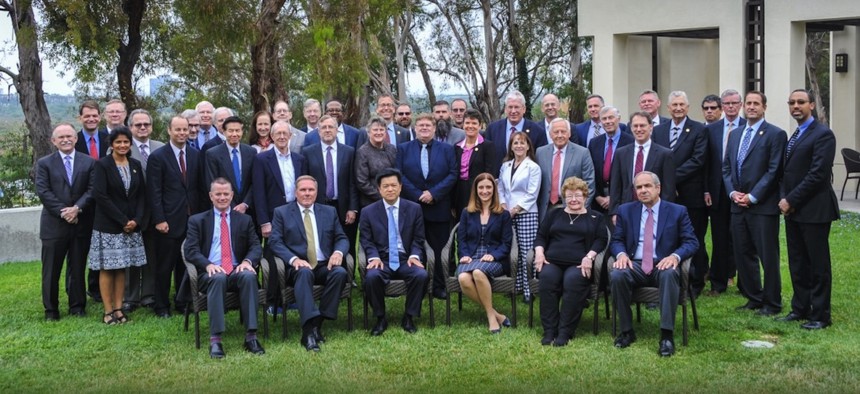
The U.S. Air Force Scientific Advisory Board meets in summer 2019 in Irvine, California. AIr Force / Jose Fernandez
What Can the Pentagon Realistically Get from Its Advisory Boards?
A former chair says the boards provide a lot, could do better — and help weed out impractical or oversold ideas.
The recently mandated zero-baseline review of the Department of Defense’s advisory boards was partially motivated by controversial recent changes to the membership of specific boards. Setting politics aside, however, the review is a great opportunity to review the effectiveness and impact of these boards. Do they serve a useful purpose? What does the Pentagon get from them?
Steve Blank, Raj Shah, and Joe Felter recently argued in Defense One that these boards should be restructured to produce ideas with revolutionary, “10X” impact. This is certainly an admirable goal, but it is probably worthwhile to incorporate into the review both a better sense for where those 10X ideas come from and the other benefits that DoD gets from those boards.
10X ideas in the national security space are rare, but the ones that have come along and really changed warfare—like nuclear weapons, ICBMs, stealth, GPS, precision munitions, and satellite-based sensing—came not from “crazy outsiders” or insiders versed in processes and politics. Rather, they arose from efforts to bring together people who understood the national security mission gaps with people who knew the limits of technology and what it took to make it real.
As a former chair of the Air Force Scientific Advisory Board, I got to see how their model brought together world-class academics with an interest in national security, senior leaders from industry with hard-won knowledge of real programs, Air Force officers with firsthand knowledge of the problems being studied, and subject matter experts from federally funded research and development centers and university affiliated research centers. These efforts produced diverse teams that built creative tension and fostered great ideas. A study on non-traditional ISR identified how sensors other than those traditionally used for ISR could contribute critical information in challenging environments. Ideas produced during a study on forward basing provided critical inputs to on-going efforts on agile combat operations.
The Board also helped inform academics from across the country about the critical problems the Air Force was facing. Those academics then spread that knowledge to their students and colleagues, generating critical research and solutions.
FFRDCs and UARCs provided analysis and assessments of system impacts at a detailed level quickly and informally in ways that provided important insight to a range of Air Force programs. Board members from these organizations brought existing tools and experienced analysts to bear on studies of compatibility of test ranges with renewable energy developments, electro-optic countermeasures, and forward basing. Junior Air Force officers learned from seasoned Board members how to bring a critical approach to technology and systems they then used throughout long careers. The structure of the Board allowed this to be done rapidly by members offering an independent view, in ways the Air Force could not do for itself or quickly contract for.
Unfortunately, the ability to bring the right subject matter expertise to bear has been hindered by the ever-growing timelines for getting consultants and members approved for studies and membership. If the current review results in cutting that timeline down from many months to a small number of weeks, the agility and applicability of all the boards would be greatly improved.
As well, the Board was often called on to assess ideas that purported to be 10X. Far more often than not, they turned out to be physically infeasible, impractical, or of little real impact.
If the current review identifies best practices like these and helps spread them across the various DoD advisory boards while articulating the benefits they provide, the pause in board activities to make that happen will be well worth it.
Eliahu Niewood is the Vice President, Intelligence and Cross-Cutting Capabilities at the MITRE Corporation. He served as the Chair of the Air Force Scientific Advisory Board from 2011-2014.



